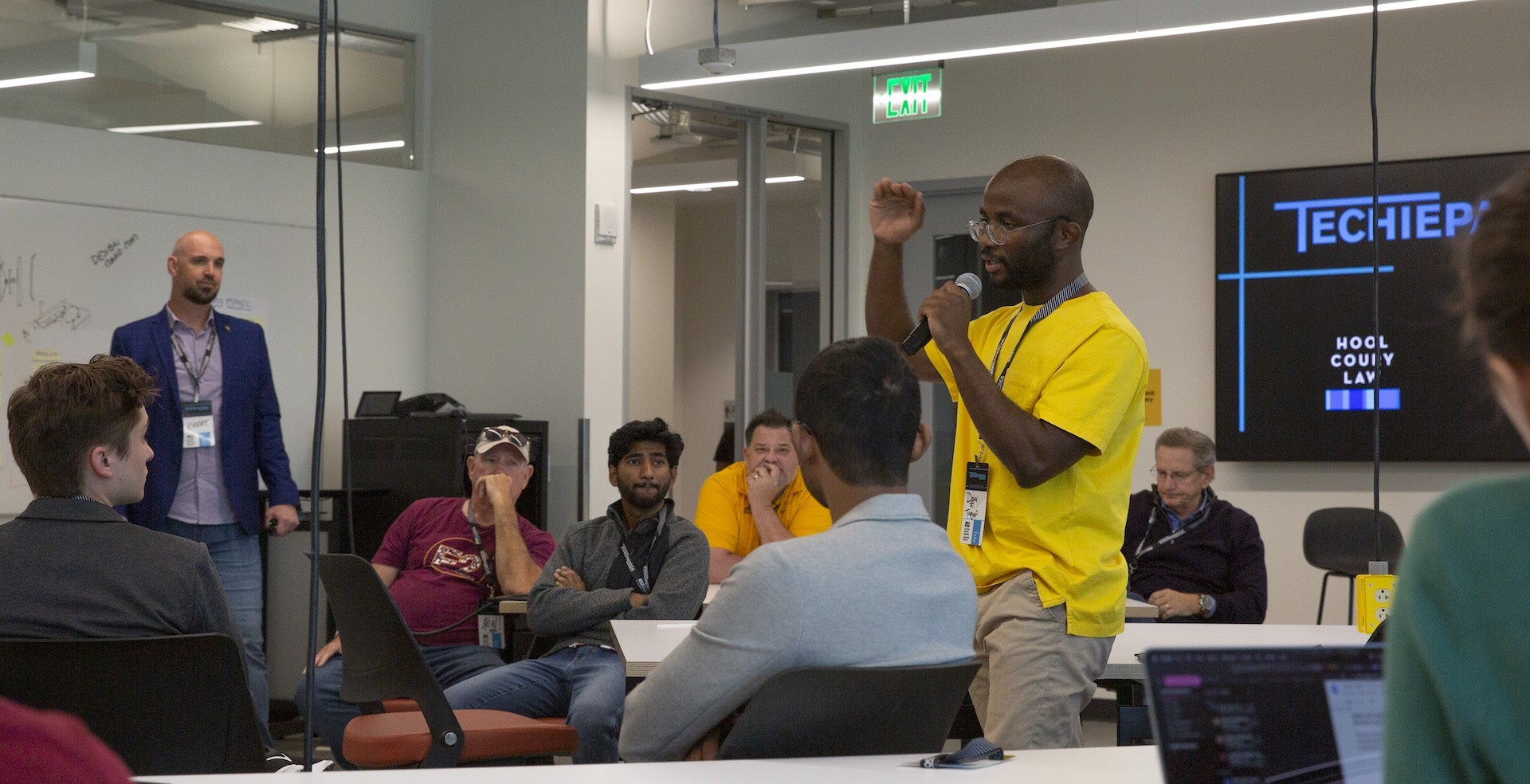Co-founding and collaborating across campus

Arizona State University faculty members Brent Sebold (left) and Michael Hool (middle), along with ASU alumnus Jake Slatnick (right), educate young entrepreneurs about founding startup companies at Techiepalooza. Photo by Erika Gronek/ASU
It’s not easy to meet someone with compatible goals, values and interests. The reality of a potentially yearslong commitment can be intimidating and make a person second-guess their connection. This is true in most relationships, especially business partners.
Michael Hool, a venture lawyer with Hool Coury Law and associate professor of law in the Sandra Day O’Connor College of Law at Arizona State University, and Brent Sebold, director of Entrepreneurship + Innovation at ASU's Ira A. Fulton Schools of Engineering, seek to help young entrepreneurs connect at the semiannual Techiepalooza event.
“We want to help students network across the colleges,” Hool says. “There could be potential collaborators just on the other side of campus, but they’d never know.”
For one afternoon, founders, techies and business owners converge to discuss their ventures and skills. Everyone from undergraduates and graduate students to local startups are encouraged to attend and learn from both companies and investors what it means to be a young company and assemble the right founding team.
An engineer might be an expert in their venture’s subject matter but will inevitably need to evolve their tech and market their work. Additionally, a founder without engineering skills may have an idea but need technical support to execute their vision. Sebold and Hool help students overcome these challenges with opportunities, such as Techiepalooza, by introducing them to other entrepreneurs with complementary skill sets to maximize their venture’s potential.
“We are the bridge between the business and engineering schools,” says Sebold, who is also the Hool Coury Law Professor of Entrepreneurship. “Any students who want to be a part of a startup have an open invitation to come together.”
Student entrepreneurs benefit from interdisciplinary teams
The founders who attended the spring Techiepalooza event are exploring a large range of ventures, including hospitality, branding, education, networking, recycling, health diagnostics and telecommunication. The variety of industries represents a testament to the program’s commitment to interdisciplinary partnerships. It’s also an appropriate reflection of the collaboration of the three major schools at ASU that co-produce the program: the Fulton Schools, the W. P. Carey School of Business and the Herberger Institute for Design and the Arts.
Max Bregman, a business data analytics student in his final year at ASU and co-founder of Breathe EV, is a long-standing proponent of the program.
“It’s been great to have a like-minded community,” Bregman says. “Dr. Sebold has been a great resource for me for forming connections, both with faculty at ASU and externally with potential customers.”
ASU alumni share their experience
Techiepalooza celebrated its enduring legacy with the return of former student entrepreneur Jake Slatnick, who was part of the first cohort to study technical management at ASU. Slatnick attributes part of his success to Techiepalooza for helping him find his co-founder, Eric Goodchild. Slatnick and Goodchild established a wireless charger company called FreePower that has since incited a bidding war on Shark Tank, has accumulated more than $50 million in funding and is currently allying with Tesla to install its wireless charging system.
Slatnick has been named in Forbes Magazine’s 30 under 30 in Manufacturing and Industry and received the Consumer Technology Association’s 2022 Innovation Award. While sharing his experiences with burgeoning founders and aspiring techies, Slatnick emphasized the importance of finding a need within the existing market.
“I saw a fundamental flaw,” Slatnick says. “Wireless charging is meant to be more convenient but had to be very precise, so we made something easier.”
Sebold notes that while the Entrepreneurship + Innovation @ Fulton, or E+I, team team enjoys seeing students develop connections, his favorite aspect of the program has been when graduates like Slatnick return years later and cite the program as where they met their co-founder.
Fulton Schools computer systems engineering alumnus Derick Tangap explains his venture, Frontier Technology Group, to the student founders attending Techiepalooza. Photo by Erika Gronek/ASU
The future of innovation and entrepreneurship
The E+I team and the Fulton Schools further encourage student ventures by granting more than $450,000 annually to support student venture success. By hosting impactful events on an international scale, the Fulton Schools plan to continue fostering a community to support and motivate students.
They recently collaborated to host the ASU Innovation Open, which invites both domestic and international collegiate teams to pitch their ventures to business leaders and technology developers.
E+I’s next event is a seed funding competition called the eSeed Challenge, which is part of the ASU Venture Devils program funding network. Teams will submit their analyses of business models, and winners will receive up to $6,000 and an all-expenses-paid trip to Silicon Valley.
“As a sponsor, I enjoy watching students grow from these events,” says Connor Hubach, a longtime supporter and mentor for E+I. “They become more confident, their pitches are more succinct and they clearly understand their market better.”
The team is eager to keep growing its network of entrepreneurs from all backgrounds and to promote entrepreneurial innovation on a global scale.
More Science and technology

ASU-led space telescope is ready to fly
The Star Planet Activity Research CubeSat, or SPARCS, a small space telescope that will monitor the flares and sunspot activity…

ASU at the heart of the state's revitalized microelectronics industry
A stronger local economy, more reliable technology, and a future where our computers and devices do the impossible: that’s the…

Breakthrough copper alloy achieves unprecedented high-temperature performance
A team of researchers from Arizona State University, the U.S. Army Research Laboratory, Lehigh University and Louisiana State…


